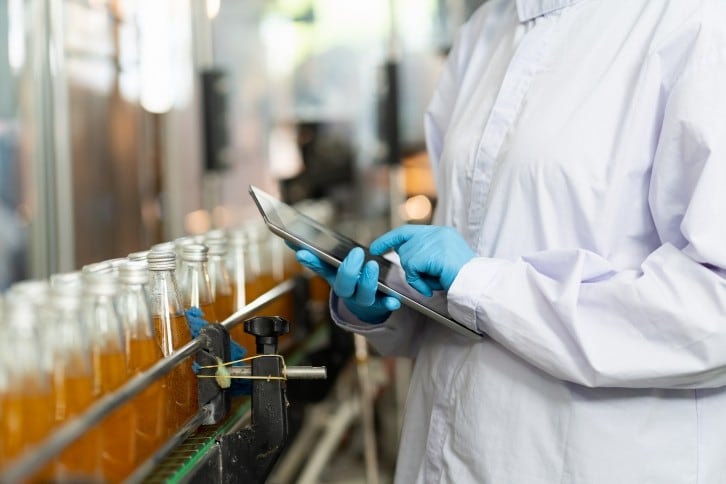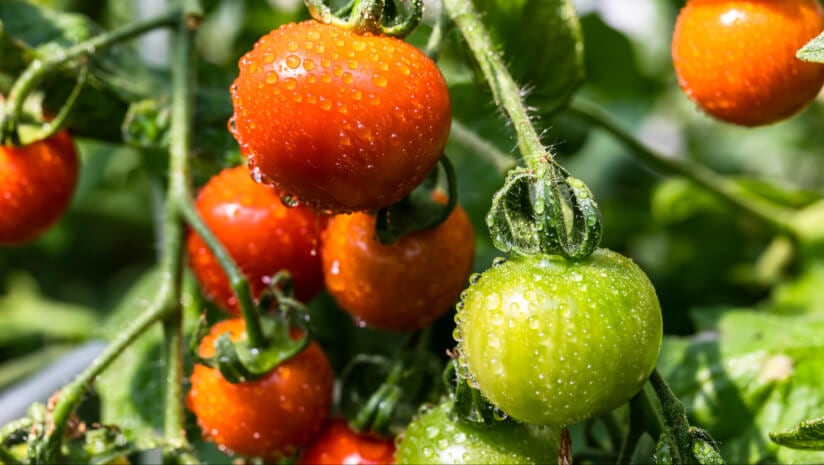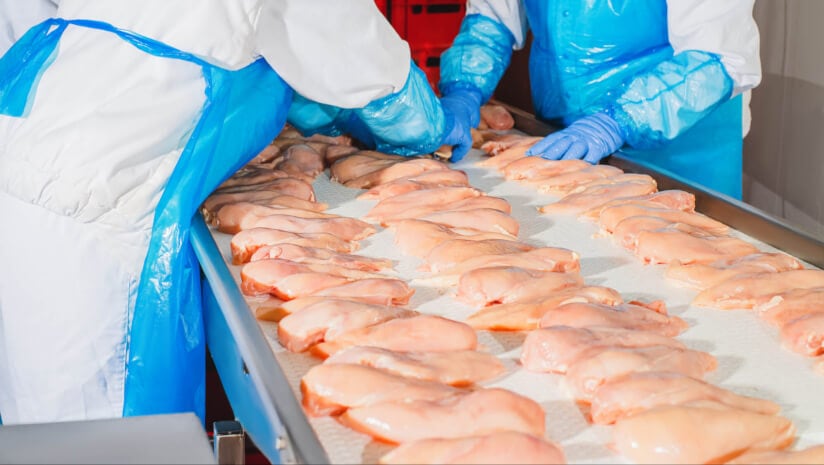1. Increasing risk of allergens
Food allergy diagnoses are rising, with new food allergy cases almost doubling between 2008 and 2018.
Recent government estimates found that now around 6% of UK adults have a food allergy – that’s approximately 2.4m people.
One reason for the rise could be changes to our diet, including the introduction of novel foods.
“We could be inadvertently exposing consumers to allergens,” warned Selvarani Elahi, UK deputy government chemist for LGC Group and executive director of the Food Authenticity Network, at Food Manufacture’s 2024 Food Safety Briefing.
While there are 14 major allergens recognised under UK law, the list of allergens extends way beyond that – we currently know about 180.
By introducing new foods, there is every chance we’ll come across even more. Take insects as an example, these have a very similar muscle proteins to crustaceans which could lead to cross reactivity.
We have also seen concerns aired around the increasing use of plant-based proteins like pea – a member of the legume family – within dairy alternatives.
As the British Society for Allergy & Clinical Immunology (BSACI) puts it: “Because allergic reactions are usually triggered by proteins, foods containing concentrated protein sources such as pea protein are likely to trigger more severe reactions if accidentally consumed by people with an allergy to that food.”
Peas are not among the 14 major allergens, so while it must be listed within the ingredients, it doesn’t need to emphasised on pack, meaning it could be more easily missed by an allergic consumer.
The risk of plant-based allergies has also been highlighted in the Food Standards Agency’s Patterns and Prevalence of Adult Food Allergy (PAFA) report, which found such allergies are affecting more people into adulthood.
As Professor Robin May, chief scientific adviser at the Food Standards Agency (FSA) noted, this is an important consideration for the UK as we see the food system move towards plant-based diets and alternative proteins.
2. New food fraud risks
Alternative proteins have also been flagged as potentially vulnerable to food fraud. A recent study funded by Defra which explored the potential for new risks regarding authenticity and labelling of alternatives, found that little consideration has been given to the risks around fraud and alternative proteins.
Elahi has raised concerns about these risks previously, citing that difficulty in sourcing or higher price tags could fuel this fire; also noting that new technologies and the requirement of pre-market regulation within the alternative protein space could also create opportunity for criminal movement.
It's not just the alternative sector that is at risk though, as Alison Johnson, founder of Food Forensics, pointed out in Food Manufacture’s 2024 Food Safety Briefing.
“The new EU deforestation regulations are putting restrictions on imports from ‘high risk’ countries,” Johnson explained. “Those high-risk countries will have to conform with more onerous traceability and documentation etc., which may well increase the potential of the incentive for origin fraud.”
But we may also see more cases akin to the recent Glen’s Vodka incident, wherein counterfeit vodka labelled as Glen’s was found to contain isopropyl alcohol.
During the pandemic, lots of businesses were set up to produce hand sanitiser and meet the increased demand. Now, with things calming down, these sites have subsequently stopped production. Johnson said she is “highly suspicious” that certain unscrupulous actors might be using up some of these raw materials that would have otherwise gone into hand sanitiser.
The cost of food crime overall is significant on the UK economy – as Terry McGrath, founder and chief scientific officer at Bia Analytical cited in his own presentation during this year’s briefing. “It costs about £7.2m to deal with a large case of food crime or fraud food” and while this impacts individuals, businesses and government, the cost burdens fall largely on the latter.
“This fight against food fraud. It's not an individual's fight,” he continued. “It's best achieved whenever lots of people are sharing information and doing it together.”
McGrath’s talk focused on the tools at industry’s disposal to fight against food fraud – and among the bells and whistles of new tech, he reminded viewers of the simple act of doing your homework whenever looking at a new supplier.
3. The complications of eCommerce
In today’s world, eCommerce is the norm and whilst offering significant benefits of ease and convenience, food fraud experts are keeping a close eye.
Described previously by Chris Elliott, lead author of the 2013 UK’s food system review following the horse scandal and president at Bia Analytical, as ‘the wild west’, the prevalence of online marketplaces makes it a complicated entity to regulate.
McGrath also gave nod to the risks associated with online shops and fraud, as well as convenience stores. During his talk, he made reference to an episode of the BBC Food Programme back in March which saw Bia Analytical’s portable testing device used to test the authenticity of a range of herbs and spices.
Of the 61 samples bought from a range of retailers, 20 were flagged as potentially problematic and sent for further analysis. The end results indicated that 7 were inauthentic.
“As suspected, they weren't found in the larger retailers who have a lot of resources to actually do their due diligence. It was found in the smaller shops and the online shops,” McGrath added.
But there are also concerns beyond fraudulent activity in online stores. In our briefing, Elahi warned that there have been incidences of “insufficient or inaccurate food safety information on websites”, making it very difficult for consumers to get accurate details on ingredients –another big risk for those with food allergies.
Her presentation also touched on so-called dark kitchens – a commercial kitchen used for the sole purpose of food deliveries.
“These are much harder to regulate because there’s much less visibility,” she explained. “Plus, the addition of third-party delivery services – whilst it’s extremely valuable to the consumer because deliveries can happen very quickly, there have been reports of inadequate cold chain storage conditions, which can obviously increase food safety risk.”
Cold storage has been a cause for concern in the meal kit space, alongside contamination. Elahi explained: “We saw in the pandemic the rising popularity of meal kits where people can now order ingredients and cook at home – which is a great thing. However, there have been studies done that show in some cases there can be insufficient cold packaging.
“Also, when packaging is inadequate you can get cross contamination, in some cases of raw meat and ready to eat produce.”
With so many cogs turning the wheels of eCommerce, this also presents another challenge – who is responsible when things do go wrong?
4. The unintended consequences of the circular economy
Whilst a closed loop system offers many advantages, it may also bring with it new problems.
“The system is designed to minimise waste and make of most resources throughout the whole food production cycle and consumption cycle,” said Elahi. “However, considerable risks to food safety can exist from water reuse, food loss and waste, and packaging waste from the persistence of pathogens, parasites, and a whole host of chemical contaminants…”
Her list went on, with the full details available via our webinar.
Johnson agreed, noting that increasing pressure to use more recycled materials means a higher risk of BPA.
“A lot of the historical materials contained BPA, so although we're trying to do one thing for a positive reason, it has a potential increased risk because of another.”
She also referenced food contact materials, stating that there is “a very interesting conflicting dynamic between reducing cost, increasing recycled [materials] and increasing shelf life. And those aren't always complementary to each other”.
5. Food terrorism and cyberattacks
As Johnson highlighted in her presentation, food terrorism and cyber threats are not often discussed but both pose “very real” risks.
“We've seen the mayhem caused by the Salisbury poisoning. If that had gone into food, for example, the potential consequences of that are unthinkable,” Johnson said.
“We're so dependent on IT in the food network, any cyber threat could be absolutely crippling, and in terms of risk, shouldn't be discounted.”
The driver of such acts could be aimed at disrupting a country’s access to food or to extort money from a business.
Cybersecurity was a key topic of the FBI’s Agriculture Threats Symposium this year, with speakers reminding attendees just how digitally connected the food system is.
“The cyber risk and the national security risk for farms and ranches and our food processing facilities is growing exponentially," said Gene Kowel, special agent in charge of the FBI’s Omaha Field Office, which partnered with the Nebraska Farm Bureau to host the August symposium. "The threats are evolving. They’re becoming more complex and more severe."
In the UK, the Cyber Security Breaches survey 2024 found that 50% of businesses have reported experiencing some form of cybersecurity break or attack in the last 12 months. This is much more likely for medium businesses (70%) and large businesses (74%).
Historically, UK food and hospitality businesses tended to regard cybersecurity as a lower priority than other industries, but this year’s report has seen it climbing the agenda, bringing the F&B sector in line with businesses overall (72% vs. 75% respectively).
The UK agriculture sector on the other hand has reported this as less of a priority, with just over half (58%) saying it’s a priority.
6. Same hazards, new places
Climate change is the most pressing issue facing our world, with the possibility of completely altering ecosystems that support life on planet Earth.
Elahi dished out some sobering facts which demonstrated how serious its impact is and will be: “Almost everything that we do emits emissions and air pollution is the largest single cause of disease and premature death in the world, with over 7m people dying every year from it.
“Incredibly, 9 out of 10 people breathe air that contains pollutants above the WHO guidelines.”
Around the world, we are hearing – and seeing – the decline of our natural world, as water, plants, animals and ecosystems suffer. This all impacts our food supplies.
“The UN Sustainable Development Goals rank highly on policy agendas all over the world, where the importance of achieving food security is acknowledged as an enabler for many of these goals,” Elahi continued. “In fact, 12 of the 17 Sustainable Development Goals are highly relevant to food and nutrition, with just over five years left to reach the UN 2030 agenda.”
Extreme weather events are becoming more frequent, more severe and unpredictable, and the consequences on agricultural production and yields is evident. But it also has a knock-on effect on food safety, as changing weathers can degrade the soil and even increase the risk of exposure to biological and chemical contaminations.
“Where we've traditionally sourced from is likely to change,” added Johnson. “So that's going to have an impact on biodiversity and deforestation.
“We've got the likelihood of an information lag, so growers might be growing crops they've never grown before. So although it's really well established in certain countries and growing areas, we’re then moving into immature agricultural control processes. So that is a whole different set of risks.
“Viruses and disease risk will change […] We're likely to see the same hazards but presenting in new areas or in new products where we haven't traditionally seen them.”
7. Lack of food safety professionals
The final risk that emerged from this year’s Food Safety Briefing probably comes as no surprise – it’s a lack of skilled workers.
The sector has been suffering with a skills gap for a long time, across a number of roles from heavy vehicle drivers to engineers and meat processors.
Between 2022 and 2023, research from the Food & Drink Federation (FDF) found that labour shortages have cost the industry an estimated £1.4bn due to loss of output.
But it’s not just the risk of high costs, it’s also a risk of lost know-how. Within the food safety world this means a lack of scientific and technical expertise., as Sterling Crew, chair at the Food Authenticity Network, pointed out during the live Q&A.
“When I speak to food leaders and we go through the 26 risks that we've identified to the food manufacturing sector, the one that always comes on top is people,” said Crew. “We are struggling to attract and retain talented people – especially in the food safety sector. Unless we have the people to interpret and act on these risks, we're in a bad way.”
Last year, the FSA’s Our Food report showed a 14% decline in food hygiene posts in Local Authorities in England, Wales and Northern Ireland over the last decade, with more 13% of available posts vacant.
In Scotland, the number of food law officers (undertaking both food hygiene and food standards work) fell by 25.5% compared to 2016/17.
The report also showed that the number of UK food standards officers also dropped over the last decade (-45%). While career uptake within UK veterinary has witnessed a 27% decrease between 2019 and 2022.
As FSA chair, Susan Jebb, said at the time of the report’s release: “Food safety and standards hinge on good procedures and skilled people to ensure that the right checks are carried out.”
You can register to watch Food Manufacture's 2024 Food Safety Briefing here. This year's briefing was kindly sponsored by Unibloc Hygienic Technologies, Kluber Lubrication, QAD Redzone, and Tracegains.
In other news, this month's podcast is out now! Food Manufacture speaks to Hilltop Honey founder and owner Scott Davies, as his regales how an unfortunate accident led to the creation of the UK's second biggest honey business.





